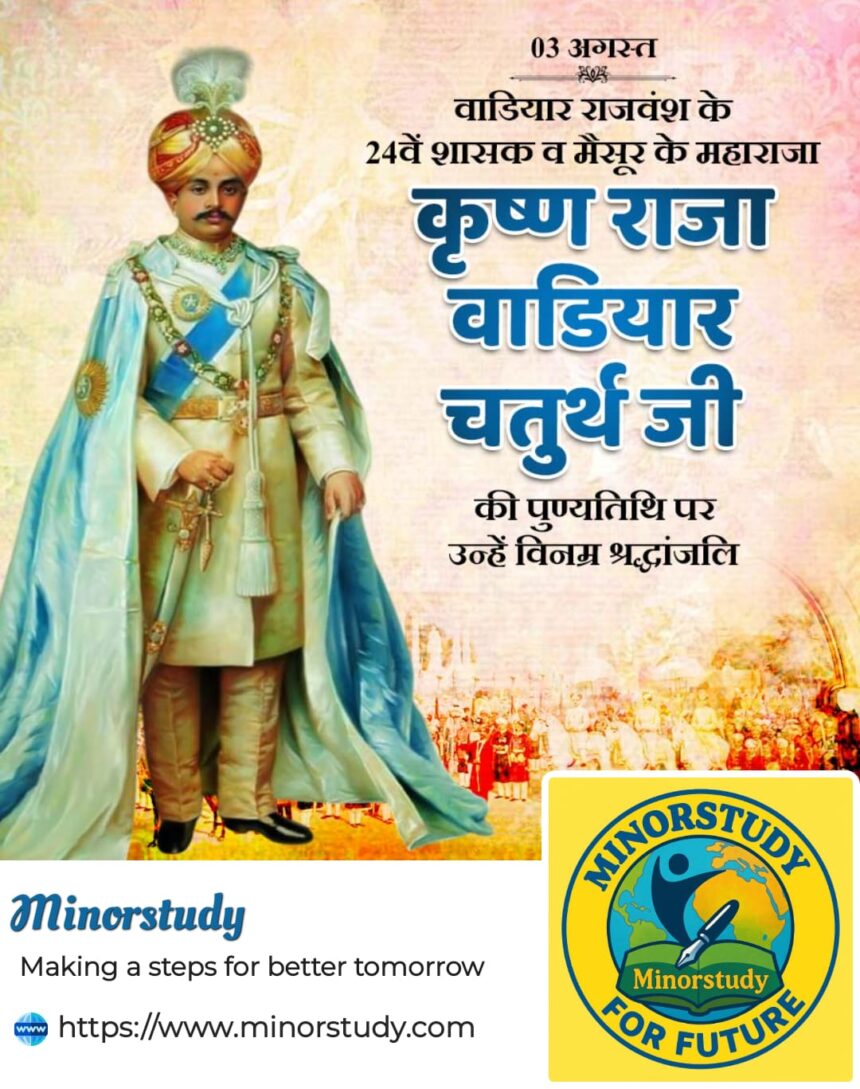Introduction: The Maharaja Who Shaped a Modern Kingdom
In the annals of Indian history, very few monarchs have been revered both as rulers and reformers. Krishna Raja Wadiyar IV, the Maharaja of Mysore, holds such a place of honor. He was not merely a king — he was a visionary, a benevolent ruler, and one of the greatest patrons of science, art, and education in modern India. Revered as “Rajarshi” (sage-king) by Mahatma Gandhi, Wadiyar IV governed with intellect and integrity, turning Mysore into a model state of progress during the early 20th century.
- Introduction: The Maharaja Who Shaped a Modern Kingdom
- 👑 History and Early Life of Krishna Raja Wadiyar IV G
- 📅 Timeline of Major Events in Krishna Raja Wadiyar IV’s Life
- 🏛️ 9 Inspiring Facts About Krishna Raja Wadiyar IV
- 🎓 Significance of Krishna Raja Wadiyar IV in Indian History
- 🧠 His Impact on Modern India
- 🎉 Observances and Memorials
- 🙏 Wishing and Remembering Krishna Raja Wadiyar IV Ji
- 💡 FAQs – Frequently Asked Questions About Krishna Raja Wadiyar IV G
- Q1. Was Krishna Raja Wadiyar IV the last ruler of Mysore?
- Q2. What was his relationship with Sir M. Visvesvaraya?
- Q3. Why is he called ‘Rajarshi’?
- Q4. What are his major contributions to Indian education?
- Q5. How is he remembered today?
- 📌 Important Points and Values from His Life
- ✨ Daily Life Impact and Why He Still Matters
- 🎯 Conclusion: The King Who Served, Not Just Ruled
This article explores the history, legacy, timeline, facts, and contemporary relevance of one of India’s most beloved monarchs.
👑 History and Early Life of Krishna Raja Wadiyar IV G
Born on 4 June 1884, in the Mysore Palace, Krishna Raja Wadiyar IV was adopted by Maharani Vani Vilas Sannidhana after the passing of Maharaja Chamarajendra Wadiyar X. He ascended the throne as a young prince in 1894 under the regency of his mother and assumed full power in 1902.
Educated by British and Indian scholars, he developed an early passion for governance, Sanskrit, philosophy, and Western science. Unlike other princely rulers of the time, he embraced democratic values, technology, and social upliftment, even under British suzerainty.
📅 Timeline of Major Events in Krishna Raja Wadiyar IV’s Life
| Year | Event |
|---|---|
| 1884 | Born in Mysore |
| 1894 | Adopted as heir to the throne; became Maharaja |
| 1902 | Assumed full administrative power at age 18 |
| 1905–1940 | Period of progressive reforms and modernization |
| 1915 | University of Mysore established (first in India by a native ruler) |
| 1927 | Hosted the Indian Science Congress |
| 1940 | Passed away on 3 August 1940 at the age of 56 |
🏛️ 9 Inspiring Facts About Krishna Raja Wadiyar IV
First Indian Prince to Establish a University
He founded the University of Mysore in 1916 — a bold step toward Indian self-education, even before India’s independence.Gandhiji Called Him “Rajarshi”
Mahatma Gandhi admired him for being a spiritual and ideal ruler — both humble and noble.Developed Mysore into a ‘Model State’
Introduced electricity, railways, industries, and irrigation systems in Mysore before many British provinces did.Promoted Women’s Education
He was a strong advocate for women’s empowerment, opening up education and job opportunities for women in early 1900s India.Patron of Indian Art and Culture
Supported Carnatic music, Mysore painting, and Sanskrit scholarship while preserving traditional Indian values.Set Up Public Health Reforms
Launched sanitation, vaccination, and clean drinking water initiatives across rural and urban Mysore.One of the Richest Men of His Time
Forbes (1937) ranked him among the top 10 wealthiest men in the world — yet he lived a simple, disciplined life.Built Hydro-Electric Power Projects
Commissioned Shivanasamudra Falls hydroelectric project — one of Asia’s earliest, powering Bangalore as early as 1905.Practiced Simple Living Despite Royalty
Wore khadi, ate vegetarian food, and refused luxury for himself while building a modern kingdom for his people.
🎓 Significance of Krishna Raja Wadiyar IV in Indian History
His reign is widely considered the “Golden Era of Mysore”. While India was still under British rule, Mysore stood out as a progressive, educated, and developed state, thanks to his initiatives.
He worked with visionary Diwans like:
Sir M. Visvesvaraya (legendary engineer)
Sir Mirza Ismail
Together, they built institutions like:
Mysore Bank (now State Bank of Mysore)
Sandalwood Oil Factory
Mysore Iron & Steel Works (now Visvesvaraya Iron and Steel Plant)
🧠 His Impact on Modern India
Many policies implemented by Krishna Raja Wadiyar IV laid the groundwork for:
Post-independence industrial development
Public sector banking
STEM-based higher education in South India
Women’s rights in pre-constitutional India
🎉 Observances and Memorials
Every year on his birth anniversary (June 4) and death anniversary (August 3):
Cultural programs are held in Mysore.
Mysore Palace is illuminated.
Government and educational institutions organize exhibitions on his contributions.
Statues, roads, parks, and academic buildings in Karnataka and India bear his name as a tribute to his lasting legacy.
🙏 Wishing and Remembering Krishna Raja Wadiyar IV Ji
“May the visionary soul of Krishna Raja Wadiyar IV continue to inspire every Indian to lead with wisdom, humility, and service.”
“On this day, let us remember the benevolent Maharaja who showed that true royalty lies in serving the people.”
“Salutes to the noble Rajarshi who brought light — literally and figuratively — into millions of lives.”
💡 FAQs – Frequently Asked Questions About Krishna Raja Wadiyar IV G
Q1. Was Krishna Raja Wadiyar IV the last ruler of Mysore?
Ans: No, he was succeeded by his nephew Jayachamaraja Wadiyar, the last reigning Maharaja before the state’s integration into India.
Q2. What was his relationship with Sir M. Visvesvaraya?
Ans: Wadiyar IV appointed Visvesvaraya as Diwan. Together, they implemented landmark infrastructure and administrative reforms.
Q3. Why is he called ‘Rajarshi’?
Ans: Mahatma Gandhi gave him this title for his saint-like lifestyle, wisdom, and service-oriented rule.
Q4. What are his major contributions to Indian education?
Ans: Established the University of Mysore and promoted scientific and philosophical research, including setting up libraries and schools for all castes.
Q5. How is he remembered today?
Ans: As a benevolent ruler, visionary reformer, and true servant of the people — through textbooks, statues, and civic institutions.
📌 Important Points and Values from His Life
Humility in Power: Taught that leadership is not about command, but about compassion.
Progressive Governance: Visionary policies in education, economy, and gender equality.
Cultural Sensitivity: Balanced Indian traditions with modern governance.
Environmental Vision: Early promoter of clean energy and irrigation.
Holistic Development: Focused equally on infrastructure and moral growth of society.
✨ Daily Life Impact and Why He Still Matters
In a world increasingly divided by inequality and short-term politics, Krishna Raja Wadiyar IV’s life is a guiding light. His governance was rooted in:
Long-term planning
Public good
Minimal personal indulgence
Maximum societal progress
His ideals influence today’s:
Policy makers
Educationalists
Social workers
Youth leaders
Entrepreneurs with a vision for social change
🎯 Conclusion: The King Who Served, Not Just Ruled
Krishna Raja Wadiyar IV G is not remembered just because he was a king — but because he was a king who served selflessly. He laid the foundation of modern Mysore and, by extension, contributed to the shaping of modern India. His reign serves as a beacon of enlightened leadership, reminding us that real power lies in creating opportunity, equality, and knowledge for all.
🔔 Final Thought
“If India had more rulers like Krishna Raja Wadiyar IV, our path to independence and progress would have been even more graceful and swift.” 🌿








